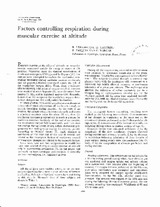| dc.description.abstract | Previous papers on the effect of altitude on muscular exercise concerned mainly the energetic aspect of this
problem. Moreover, since the classical observations of Zuntz and colleagues, 1906 (quoted by Dejours (4), few authors have attempted to explain the mechanism controlling breathing during muscular exercise at altitude
and the papers published concerned mainly the role of the ventilatory oxygen drive. Thus, these ventilatory
effects following inhalation of oxygen-enriched mixtures were studied in acute hypoxia ( 1), in acclimatized lowIanders (3, 12), and in highland natives ( 14). Recently, Lahiri et al. (9) compared the ventilatory oxygen drive
in four Sherpas and five acclimatized lowlanders. In other studies, Dejours (4) proposed a neurohumoral theory which takes into account all the factors thought to … | es_ES |

